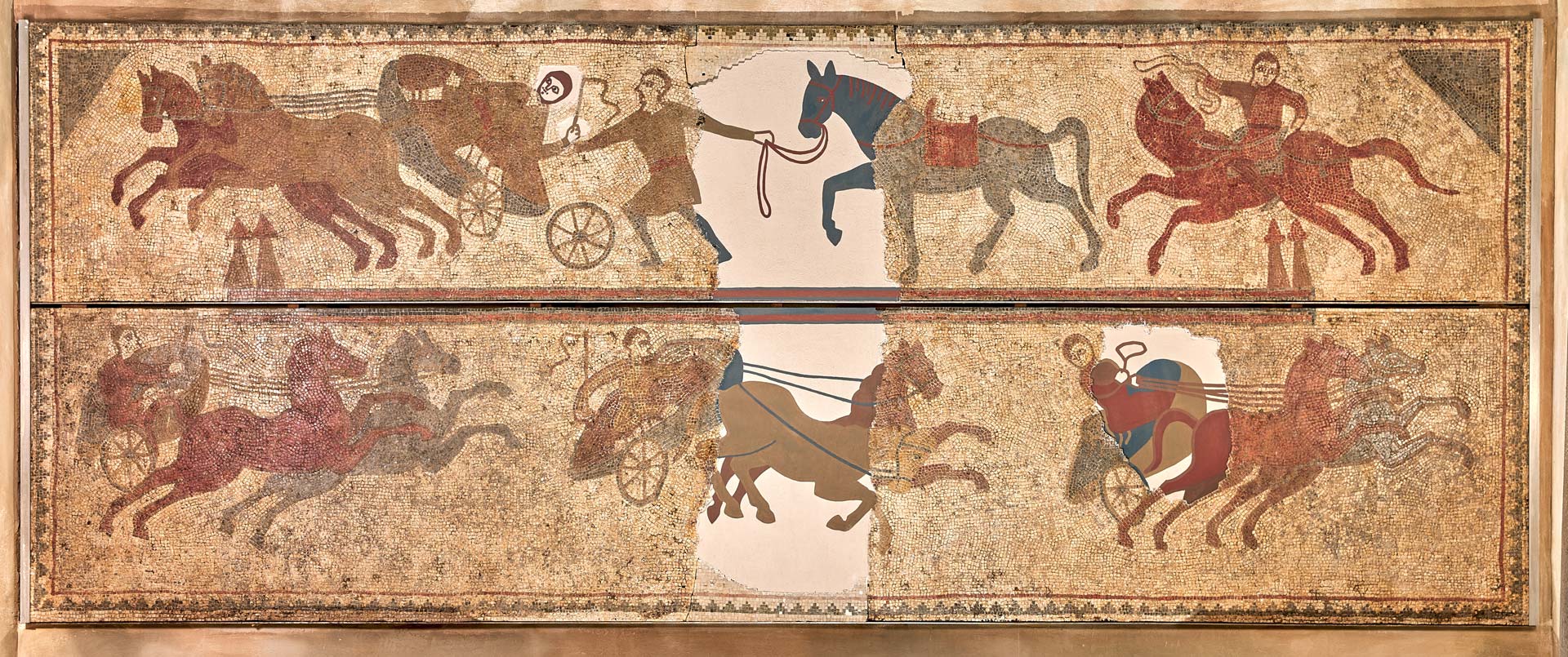Roman Mosaics
We have an important collection of Roman mosaics from the East Riding of Yorkshire. These impressive displays come from the villa sites of Brantingham, Horkstow and Rudston. Not only are the mosaics beautiful, they're also of great local and national significance.
You can visit the mosaics in person at our museum and imagine what it would have been like to have these in your home.

The First Mosaics
The earliest mosaics were made in Greece in the fourth and third centuries BC. Early mosaics were black and white pebbles set into patterns – at that time, the use of colour was rare. By the second century BC, mosaicists were using tesserae. These are small, specially hand-cut cubes of stone, marble, clay and glass. The use of tesserae meant that more complicated designs were possible.
How were mosaics made?
Mosaic designs were often chosen from a pattern book of fairly standard designs. From there, a mosaicist would calculate the number of tesserae needed in each size, shape and colour. It's estimated that the Charioteer Mosaic from the villa at Rudston, East Yorkshire contains some 150,000 tesserae!
Tesserae were either made in the stonemason’s workshop or on the site where the new floor would be laid. The mosaic had to be well-drained. So, if possible, it was laid over a hypocaust system. (This was an ancient Roman heating system that used a hollow space under the floor to circulate warm air.) Where there was no hypocaust, workers would make a foundation of pounded sand, gravel or rubble.
They then spread a layer of concrete, opus signinum (containing crushed brick or tile) or lime mortar over the foundation. The tesserae were set into the top layer while it was still wet and grouted with a slurry of fine mortar. The pattern was sometimes marked out on the surface first and the tesserae laid out using rules and set squares. The mosaic was then rolled and polished.
What materials were used?
Materials were rarely imported into Britain specifically for mosaic-making. Instead, stonemasons made tesserae from whatever materials were locally available. If chippings or broken fragments of imported marble, glass or pottery were available, they would also use those.
Mosaicists chose different materials for their colour. The Charioteer Mosaic, for example, contains white and yellow varieties of chalk. It also has Blue Lias limestone, coloured sandstones and bright red brick or tile. The range of colours possible is best shown by the Venus Mosaic, again from the villa at Rudston. This mosaic has tesserae in red, bluish-black, grey, yellow ochre, brown, green and white.
How did they choose the design?
Mosaic floor designs were very similar. Throughout the Roman world, the same themes and motifs occur time and again. This is partly explained by the mobility of the craftsmen who moved around the provinces. It's also because homeowners would choose suitable designs from pattern books. Mosaicists didn't always copy the patterns to the letter – some individuality was possible. You can see this customisation in the use of gladiatorial animals in the Venus Mosaic.
Who Made Mosaics?
Before the Roman Conquest, mosaic making was an alien art form to the British. As such, many early mosaics were made by craftsmen from Italy or Greece. They probably trained local people in the art and it's likely that a native trainee made the Venus Mosaic.
How do archaeologists lift mosaics?
There are two principal methods of lifting mosaics. In both methods, the mosaic is first secured by sticking gauze to its surface with water-soluble adhesive.
The most common method is to lift the mosaic in sections. Vertical cuts are made along the design lines. This minimises ugly joints when the sections are reassembled. As the bedding is undercut, boards are slid underneath and the section is lifted.
The second method is rolling. This is how we lifted most of the mosaics in our display. Rolling is only possible if the bedding is soft and the mosaic surface is level. As the name suggests, the mosaic is slowly rolled up. This is usually done in one piece around a reinforced drum while being slowly undercut.
Cleaning the mosaics
As you can probably imagine, cleaning the mosaics is a delicate business. Here’s a little look behind the scenes.

